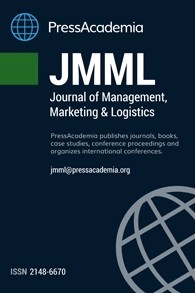RELATIONSHIP BETWEEN DOMESTIC LOGISTICS OPPORTUNITY EFFICIENCY AND INTERNATIONAL LOGISTICS OPPORTUNITY EFFICIENCY BASED ON MARKET POTENTIAL: EMPIRICAL RESEARCH ON DEVELOPING COUNTRIES
RELATIONSHIP BETWEEN DOMESTIC LOGISTICS OPPORTUNITY EFFICIENCY AND INTERNATIONAL LOGISTICS OPPORTUNITY EFFICIENCY BASED ON MARKET POTENTIAL: EMPIRICAL RESEARCH ON DEVELOPING COUNTRIES
Domestic logistics opportunity, international logistics opportunity, emerging market potential, DEA linear regression analysis,
___
- Brueckner, M. Carneiro, F. (2017). Terms of trade volatility, government spending cyclicality, and economic growth. Review of International Economics. 25(5), 975-989. DOI: 24513/Apalall.2017.123
- AEMLI (2022), Agility Emerging Markets Logistics Index 2022, available from https://www.agility.com/en/emerging-markets-logistics index/#:~:text=They%20offer%20insights%20into%20strategic,business%20conditions%20and%20digital%20readiness, access date: 01.06.2022.
- Bienstock, C. C., Mentzer, J. T., & Bird, M. M. (1997). Measuring physical distribution service quality. Journal of the Academy of marketing Science, 25(1), 31-44.
- Bugarčić, F. Ž., Skvarciany, V., & Stanišić, N. (2020). Logistics performance index in international trade: case of Central and Eastern European and Western Balkans countries. Business: Theory and Practice, 21(2), 452-459.
- Charnes, A., Cooper, W. W., & Rhodes, E. (1978). Measuring the efficiency of decision making units. European Journal of Operational Research, 2(6), 429-444.
- Civelek, M.E., Uca, N., & Çemberci, M. (2015). The mediator effect of logistics performance index on the relation between global competitiveness index and gross domestic product. European Scientific Journal, 11(3), 368- 375.
- Daugherty, P. J., Stank, T. P., & Ellinger, A. E. (1998). Leveraging logistics/distribution capabilities: the effect of logistics service on market share. Journal of Business Logistics, 19(2), 35.
- Demir, O., Poyraz, S., Üre, S. & Karaköy, Ç. (2021). Gayrisafi Sabit Sermaye Oluşumlarinin Yeni Gelişen Pazarlar Lojistik Performans Endeksi Üzerindeki Etkis., ICCDSS, 22-24 Ekim 2021, 29-38.
- Ekici, Ş. Ö., Kabak, Ö., & Ülengin, F. (2019). Improving logistics performance by reforming the pillars of Global Competitiveness Index. Transport Policy, 81, 197-207.
- Erkan, B. (2014). The importance and determinants of logistics performance of selected countries. Journal of Emerging Issues in Economics, Finance and Banking, 3(6), 1237-1254.
- Fikru, E. (2021). The effect of freight transport service performance on global market competitiveness. Studies in Economics and Business Relations, 2(2), 89-99.
- Göçer, A., Özpeynirci, Ö., Semiz, M., (2021). Logistics performance index-driven policy development: An application to Turkey. Transport Policy, 124, 20-32 DOI: https://doi.org/10.1016/j.tranpol.2021.03.007
- Hannah, L. (2008). Logistics, market size, and giant plants in the early twentieth century: a global view. The Journal of Economic History, 68(1), 46- 79.
- Kabak, Ö., Ekici, Ş. Ö., & Ülengin, F. (2020). Analyzing two-way interaction between the competitiveness and logistics performance of countries. Transport Policy, 98, 238-246.
- Kline, R. B., (2011). Principles and practice of structural equation modelling (3rd ed.). New York, Guilford press.
- Korinek, J., & Sourdin, P. (2011). To What Extent Are High-Quality Logistics Services Trade Facilitating? (No. 108). OECD Publishing.
- Liu, J., Yuan, C., Hafeez, M., & Yuan, Q. (2018). The relationship between environment and logistics performance: Evidence from Asian countries. Journal of Cleaner Production, 204, 282-291.
- Lu, M., Xie, R., Chen, P., Zou, Y., & Tang, J. (2019). Green transportation and logistics performance: An improved composite index. Sustainability, 11(10), 2976.
- Maiboroda, O. Y., Bezuhla, L. S., Gukaliuk, A. F., Shymanska, V. V., Momont, T. V., & Ilchenko, T. V. (2020). The global value of distribution networks and logistic opportunities. International Journal of Economics & Business Administration (IJEBA), 8(1), 227-238.
- Martí, L., Martín, J. C., & Puertas, R. (2017). A DEA-logistics performance index. Journal of Applied Economics, 20(1), 169-192.
- Mentzer, J. T., Myers, M. B., & Cheung, M. S. (2004). Global market segmentation for logistics services. Industrial Marketing Management, 33(1), 15-20.
- Mentzer, J. T., & Williams, L. R. (2001). The role of logistics leverage in marketing strategy. Journal of Marketing Channels, 8(3-4), 29-47.
- MPI (2021), Market Potential Index, https://globaledge.msu.edu/mpi, access date: 01.06.2022.
- Newbold, P. (2000). İşletme ve iktisat için istatistik (Çev. Ü.Şenesen) (4. baskı), literatür yayıncılık.
- Polat, M., Kara, K., & Yalcin, G. C. (2022). Clustering countries on logistics performance and carbon dioxide (CO2) emission efficiency: An Empirical Analysis. Business and Economics Research Journal, 13(2), 221-238
- Puertas, R., Martí, L., & García, L. (2014). Logistics performance and export competitiveness: European experience. Empirica, 41(3), 467-480.
- Sergi, B. S., D’Aleo, V., Konecka, S., Szopik-Depczyńska, K., Dembińska, I., & Ioppolo, G. (2021). Competitiveness and the logistics performance index: the ANOVA method application for Africa, Asia, and the EU regions. Sustainable Cities and Society, 69, 102845.
- Uca, N., İnce, H., & Sümen, H. (2016). The mediator effect of logistics performance index on the relation between corruption perception index and foreign trade volume. European Scientific Journal, 12(25), 37-45.
- Wang, M. L., & Choi, C. H. (2018). How logistics performance promotes the international trade volume? A comparative analysis of developing and developed countries. International Journal of Logistics Economics and Globalisation, 7(1), 49-70
- Yayın Aralığı: Yılda 4 Sayı
- Başlangıç: 2014
- Yayıncı: PressAcademia
EFFICIENCY OF SOCIAL RESPONSIBILITY PROJECTS PROMOTED IN SOCIAL MEDIA
Hilal YASATEKIN, Fahri APAYDIN
AGRICULTURAL-FOOD SUPPLY CHAIN DESIGN WITH THE CPFR APPROACH: AN APPLICATION
Atiye TUMENBATUR, Mehmet TANYAS, Emre CAKMAK
THE FACTORS OF MARKETING CHANNEL SELECTION OF QUEEN PINEAPPLE FARMERS IN CAMARINES NORTE
